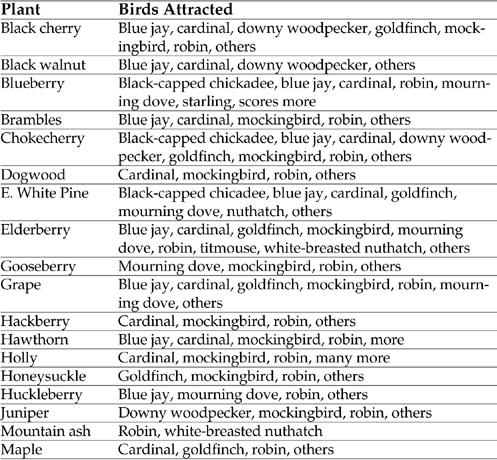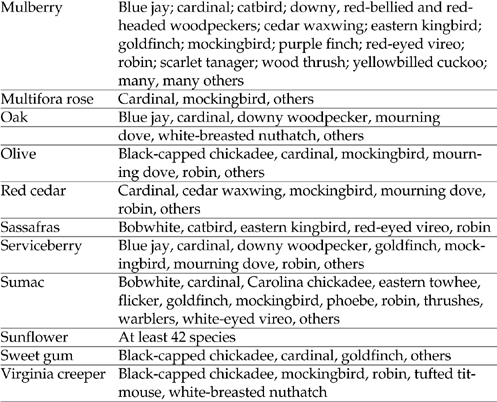Bird Food Recipes
Rhonda Massingham Hart

CONTENTS
Introduction
Just outside your frost-framed windows, half a dozen fat, squabbling chickadees heartily partake of this mornings offering. You smile to yourself. Not only do you enjoy the company of your feathered friends, but you also have the satisfaction of giving Nature a hand when she needs it most.
Feeding wild birds is a wonderful way to enjoy and study nature. Millions of people every year set out winter feeders to entice winged wildlife to their backyards. Some of these feeders are gleefuly accepted by hordes of hungry birds, some are patronized, but much of the food is never consumed, and still others are virtually ignored. Is there some secret to luring birds to your feeder?
A basic understanding of a wild birds needs will make any bird-feeding venture more successful. His first concern is for safety. He will not approach a feeder that in any way appears threatening. Nearby cover, such as dense trees or a pile of brush, should be provided for nervous customers, and the feed must be placed well out of reach of any prowling cats or other predators. Birds are creatures of instinct and habit. Once they have established a routine flight pattern, you must provide a more attactive alternative if you expect them to include your feeder in their schedule. Nesting sites, either natural or man-made, may invite birds to remain in your yard. A supply of natural food sources, such as fruit- or nut-bearing trees or shrubs, will also find favor among the feathered. A reliable supply of water, especially during extreme weather conditions, is highly appreciated.
Though most folks associate bird feeding with the ravages of winter, getting the most from your feeder really means offering prime goodies all year round. This is what makes some feeders the main attraction. Having a regular stop, well-stocked with easy pickins, may well be the reason many birds choose to overwinter, but it can also keep yearly residents interested throughout the seasons.
The types of birds that come to your feeder will depend on your geographic location, the time of year, and the types of feeders and food you provide. Different birds have different feeding habits, and a variety of food and feeders will attract the most diverse variety of takers.
 Natural Menus
Natural MenusSeed Eaters. Most songbirds belong to this broad category. Many eat a combination of seeds and bugs, depending on the time of year. Finches, cardinals, grosbeaks, and sparrows are but a few of the primarily seed-eating birds that are attracted to feeders.
Some Prefer Fruit. Birds that might otherwise ignore your feeders, such as Bohemian and cedar waxwings, orioles, or mockingbirds, can often be bribed with orange halves, apple pieces, or other fruit. Sometimes these offerings take a while to be noticed. Dont give up if the first few offerings are not instantly devoured.
Bugs for Supper. Bug eaters, such as woodpeckers, nuthatches, and robins, may show little interest in your feeders. But come winter they will flock to suet and suet substitutes. Tempt them in the spring with a squirmy tray of mealworms. Most seed eaters will also indulge in insects in the spring when they are raising young.
Some Sip Nectar. Hummingbirds are a delightful addition to any yard. They are primarily attracted to natural food sources, such as flowers and blooming vines and shrubs. They also feed on tiny soft insects found among these blossoms. Hummingbirds will visit nectar feeders on a regular basis if they are kept filled, clean, and free from pests, such as yellow jackets. Also, fruit-loving warblers, orioles, tanagers, and grosbeaks have a taste for the sweet nectar solutions.
N ATURAL F OOD S OURCES TO A TTRACT B IRDS


Garden flowers, such as bachelor buttons, calendula, California poppy, campanula, chrysanthemum, cone flower, coreopsis, cosmos, dusty miller, marigold, phlox, verbena, and zinnia, among others, also attract an array of birds.
Favorite Hummingbird Plants

Bird Feeders
Bird feeders come in several types, each designed to serve a specific purpose. Selective feeders discourage nuisance-type birds, such as starlings, crows, and house sparrows. These feeders have very short or no perches, which makes feeding difficult to impossible for chunky visitors, while inviting small, agile birds, such as chickadees, finches, and nuthatches to enjoy a free meal. Non-selective feeders welcome one and all. Any large, accessible feeder with plenty of parking space may be considered a non-selective feeder. While selective feeders are hung from a branch or line to prevent certain birds from feeding, non-selective feeders can cater to ground birds as well as those that prefer to dine higher up.
Other distinctions in feeders include the type of feed they dispense and the manner in which they release it. Hopper feeders funnel seed down into a feeding tray until the hopper bin is empty. They can accommodate different sized seed and usually have clear sides so that you can monitor the contents. They may be set on a stump, tabletop, or windowsill, attached to a post or hung from branches, eaves, or a pulley string. The latter allows you to reel the feeder in for refills or to gradually move it closer to the window for viewing, as the birds become accustomed to its position. These feeders require very little upkeep as they are virtually self-cleaning. If for some reason the level of food does not go down within a few days, check to be sure the seed is not moldy.
Tube feeders are clear plastic cylinders often designed to release seed at several outlets. They are selective feeders that hang freely and sway with the breeze or the weight of perching birds; conditions which discourage larger birds but beckon to small chickadees, house finches, and others. Shortening the perches to H inch will limit accessibility to only the smallest customers. Specialized tube feeders dispense tiny thistle (niger) seed, highly prized by goldfinches and siskins, one seed at a time. This is perfectly suited to their habit of flying to a safe place with each seed they find before eating it.
A tray or platform-type feeder can be set near or at ground level to entice a nearly limitless variety of birds. It can hold anything from seeds and nuts to fruit and suet. It is a non-selective type feeder, allowing for the greatest possible variety of birds.
Suet feeders are specially made to hold solid suet or suet mixtures or substitutes. They can be as simple as a hanging mesh bag (such as an onions or oranges bag), a piece of hardware cloth bent to shape and nailed in place, or a large pine cone smeared with fat. Fancier versions can be store bought or created from small logs with holes bored to hold the suet.






